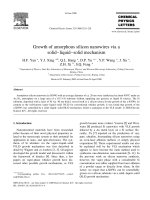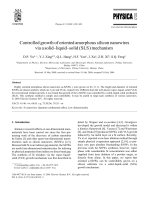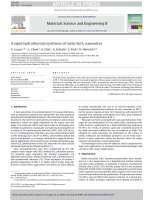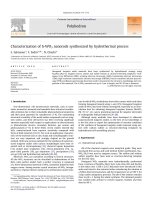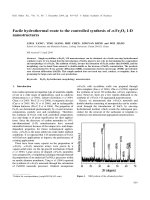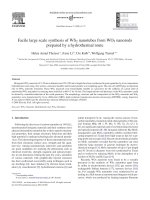- Trang chủ >>
- Khoa Học Tự Nhiên >>
- Vật lý
synthesis of one-dimensional sno2 nanorods via a hydrothermal technique
Bạn đang xem bản rút gọn của tài liệu. Xem và tải ngay bản đầy đủ của tài liệu tại đây (423.65 KB, 4 trang )
Synthesis of one-dimensional SnO
2
nanorods via a hydrothermal technique
O. Lupan
a,b,
Ã
, L. Chow
a
, G. Chai
c
, H. Heinrich
a,d,e
, S. Park
a
, A. Schulte
a
a
Department of Physics, University of Central Florida, PO Box 162385, Orlando, FL 32816-2385, USA
b
Department of Microelectronics and Semiconductor Devices, Technical University of Moldova, 168 Stefan cel Mare Blvd., Chisinau MD-2004, Republic of Moldova
c
Apollo Technologies, Inc. 205 Waymont Court, S111, Lake Mary, FL 32746, USA
d
Advanced Materials Processing and Analysis Center, University of Central Florida, Orlando, FL 32816, USA
e
Department of Mechanical, Materials, Aerospace Engineering, University of Central Florida, Orlando, FL 32816, USA
article info
Article history:
Received 19 August 2008
Received in revised form
7 October 2008
Accepted 8 October 2008
Available online 17 October 2008
PACS:
81.10.Dn
61.46.Àw
61.46.Km
68.37.Lp
78.30.Fs
Keywords:
SnO
2
nanorod
Crystal structure
Semiconductors
Hydrothermal synthesis
Raman spectra
abstract
We have developed a simple solution process to synthesize tin oxide nanorods. The influence of
precursors and the reaction temperature on the morphology of SnO
2
is investigated. SnO
2
nanorods are
characterized by X-ray diffraction (XRD), transmission electron microscopy (TEM), scanning electron
microscopy (SEM), and Raman spectroscopy. The as-grown SnO
2
nanorods are un iform in size with a
radius of 50–100 nm and length of 1–2
mm. The nanorods grow direction is parallel to the [1 01]
direction. Possible growth mechanism of SnO
2
nanorods is discussed.
& 2008 Elsevier B.V. All rights reserved.
1. Introduction
Controlled synthesis of nanostructures is an important step for
the manufacturing of nanodevices. Performance of semiconductor
nanodevices may depend on their morphology. Recently, one-
dimensional (1D) materials have attracted great interest due to
their potential applications as interconnects and functional
components [1–5]. 1D oxide nanostructures showed interesting
properties, chemical and thermal stability, diverse functionalities,
high durability, owing to their high degree of crystallinity [3], and
emerge as nanoscale building blocks for electronic and optoelec-
tronic devices [4,5]. At the same time, the interest in developing
parts per billion (ppb)-level gas sensors requires new approaches
and new nanomaterials. One of the most important sensor
materials is tin oxide (SnO
2
), which is a low-cost, large-bandgap
(3.6 eV, at 300 K), and n-type semiconductor [6]. SnO
2
’s properties
are greatly affected by the size and morphology, which define
their further applications. Thus, designing SnO
2
1D nanorods and
nanoarchitectures with well-defined morphologies is of impor-
tance for fundamental research and high-tech applications.
F abrication of SnO
2
nanorods has b een accomplished using s everal
vapor deposition techniques, such as rapid oxidation [7],chemical
vapor d eposition ( CVD) [8], and thermal ev aporation [9].Pengetal.
[1 0] hav e recently reported a hydrotherma l synthesis of SnO
2
nanorods. However, organic reagents such as hexanol and sodium
dodecylsulfate used in the synthesis of SnO
2
nanorods can lead t o
undesirable impact on human health and on the envir onment [6].
Zhang et al. [11] also report ed a low-t emperatur e fabrication (at
200 1C for 18 h) via a hydro thermal process of crystalline SnO
2
nanorods. Vayssieres et al. [1 2] reported SnO
2
nanorods arrays gro wn
on F-SnO
2
glasssubstratesbyaqueousthermohydrolysisat951C.
In this work we report a simple, one-step low-temperature
aqueous synthesis of SnO
2
1D nanorods without the need of
templates or surfactants.
2. Experimental details
The SnO
2
nanorods were synthesized via a hydrothermal
method, which is similar to the method used in SnO
2
microcubes
ARTICLE IN PRESS
Contents lists available at ScienceDirect
journal homepage: www.elsevier.com/locate/physe
Physica E
1386-9477/$ -see front matter & 2008 Elsevier B.V. All rights reserved.
doi:10.1016/j.physe.2008.10.001
Ã
Corresponding author at: Department of Physics, University of Central Florida,
4000 Central Florida Blvd PO Box 162385, Orlando, FL 32816-2385, USA.
Tel.: +1407 8235217.
E-mail address: (O. Lupan).
Physica E 41 (2009) 533–536
[13] and ZnO nanorods synthesis [14]. In a typical synthesis, 50 ml
SnCl
4
aqueous solution (in deionized (DI) water resistivity—18.2
M
O
cm) in the presence of 1 ml of HCl (37%) and NH
4
OH (29.5%)
(Purchased from Fisher Scientific) solution was mixed and stirred
for 5 min. The mixing solution was then transferred to a reactor
[14]. It was heated to 951C and kept for 15 min. Then the system
was allowed to cool to 40 1C naturally. A silicon substrate were
cleaned as previously described [15] and placed inside the reactor.
The structural properties of SnO
2
nanorods were determined
by X-ray diffraction (XRD) (Rigaku ‘D/Max-b(R)’ X-ray diffract-
ometer with CuK
a
radiation and a normal
y
–2
y
scan) [14]. The
morphologies of the SnO
2
nanorods were studied by a scanning
electron microscopy (SEM). Transmission electron microscopy
(TEM) observation of the samples was performed with a FEI
Tecnai F30 TEM operated at an accelerating voltage of 300 kV. For
the TEM observation, the products were collected on a holey
carbon grid. Micro-Raman measurements were performed at
room temperature on a Horiba Jobin Yvon LabRam IR system at a
spatial resolution of 2
m
m. Raman scattering was excited with the
633 nm line of a He–Ne laser with output power o4 mW at the
sample.
3. Results and discussion
Fig. 1 shows the SEM images of the as-grown products
synthesized on SiO
2
/Si substrates. The products consist of
nanorods as well as nanoparticles. The diameters of SnO
2
nanorods are in the range of 100–150 nm with lengths of the
order of 1–2
m
m. The end planes of the nanorods are tetragonal
(see inset Fig. 1a).
The morphology of nanorods is found to be dependent on the
synthesis conditions. The dimensions and aspect ratio are a
function of growth time, temperature and Sn
+
/OH
À
ratio in
solution.
The XRD pattern of SnO
2
nanorods is shown in Fig. 2. There are
peaks with 2
y
values of 26.971, 34.341, 38.261, 52.011, 54.901,
71.281, and 78.401, corresponding to SnO
2
tetragonal rutile crystal
planes of (11 0), (10 1), (2 0 0), (2 11), (2 2 0), (2 0 2), and (3 21),
respectively. Observed peaks can be indexed to the rutile-
structured SnO
2
with lattice constants a ¼ b ¼ 0.4738 nm and
c ¼ 0.3185 nm, (JCPDS-PDF# 021-1250)(ICSD data) [16]. Two SiO
2
peaks were observed at 44.701, a reflection from (114), and at
68.871, a reflection from (7 8 3) planes. The XRD pattern
demonstrates that the products grown under hydrothermal
conditions are SnO
2
of good crystallinity, with the obtained
diffraction peaks, broadened by the small diameter of the
nanorods.
A TEM image of a single SnO
2
nanorod with a diameter of
about 100 nm is shown in Fig. 3. Further characterization was
performed using HRTEM. Fig. 3b shows an HRTEM image of a
nanorod. The corresponding selected-area electron diffraction
(SAED) pattern taken from a section of the nanorod shown in Fig.
3c can be indexed to the tetragonal cell with lattice constants of
a ¼ 0.474 nm and c ¼ 0.318 nm, in agreement with the XRD result.
The SAED pattern also confirms that the nanorod is a single
crystalline rutile SnO
2
with preferential growth direction along
the [10 1] direction, confirming the XRD analysis.
Raman spectra are sensitive to crystallinity, defects and
structural disorder in nanoarchitectures. Therefore, the vibra-
tional properties of SnO
2
nanorods were studied by Raman
spectroscopy.
Fig. 4 shows Raman spectra in Stokes frequency range
(200 cm
À1
–850 cm
À1
) of the products annealed for 1 h at 370 1C.
There are Raman peaks at 475, 632, and 774 cm
À1
in the Raman
spectrum which are in agreement with those of a rutile SnO
2
ARTICLE IN PRESS
Fig. 1. SEMs of the SnO
2
nanorods hydrothermally grown (a) and closer view (b).
Inset shows a magnified image of cross section of the SnO
2
nanorods.
Fig. 2. The XRD pattern of the SnO
2
nanorods grown via the hydrothermal method.
Fig. 3. (a) The TEM image of a SnO
2
nanorod on a holey-carbon TEM grid. (b) Enlarged HRTEM image of a single-crystalline SnO
2
nanorod and (c) the corresponding
selected-area electron diffraction (SAED) pattern taken from a section of the nanorod.
O. Lupan et al. / Physica E 41 (2009) 533–536534
single crystal [17] and in agreement with data of group-theory
analysis [18,19]. These peaks are attributed to the E
g
, A
1g
, and B
2g
vibrational modes of SnO
2
[20].
SnO
2
with the rutile structure belongs to the space group P42/
mnm and point group D
4h
[21]. The k ¼ 0 optical modes and their
infrared (IR) and Raman (R) activity can be presented as follows
[21]:
G
¼ A
1g
ðRÞþA
2g
ðFÞþA
2u
ðIR; kÞ þ B
1g
ðRÞþB
2g
ðRÞ
þ 2B
1u
ðFÞþE
g
ðRÞþ3E
u
ðIR; ?Þ (1)
Raman active modes are A
1g
, B
1g
, B
2g
, and E
g
, in these modes the
oxygen atoms vibrate while the Sn atoms are at rest. The E
g
mode
represents vibrations in the direction of the c-axis, but A
1g
and B
1g
are modes describing vibrations perpendicular to the c-axis [21].
Seven modes of A
2u
and 3E
u
are IR active and two modes of A
2g
and B
1u
are inactive [22]. Fig. 4 shows the Raman spectra for A
1g
mode which were broadened as the size of SnO
2
nanorods
decreased [23]. The E
g
, A
1g
, and A
2g
are depicted in the Raman
scattering spectra and confirm the rutile structure of SnO
2
nanorods.
4. A proposed growth mechanism
Understanding of the growth mechanism of nanorods without
the need in templates, surfactants or applied field is very
important for the synthesis of new materials as well as for device
applications.
A proposed growth mechanism of SnO
2
nanorods can be
explained in terms of chemical reactions and crystal growth as
follows. From the crystallization point of view, the synthesis of an
oxide during of an aqueous solution reaction is expected to
experience a hydrolysis-condensation (nucleation-growth) pro-
cess.
In our experiments, we observe that the shape and aspect ratio
of the as-prepared SnO
2
products is changed and decreases by
varying the molar ratio of SnCl
4
to NH
4
OH from 20:1 to 10:1,
which is in agreement with the previous reports [11,24].
Growth of SnO
2
nanorods occurs according to the total reaction
[11,24]:
Sn
4þ
þ 4OH
À
! SnO
2
þ 2H
2
O (2)
Sn
4þ
þ 4OH
À
! SnðOHÞ
4
(3)
The amphoteric hydroxide Sn(OH)
4
dissolves in excess of
ammonia solution and forms [Sn(OH)
6
]
2À
anions:
SnðOHÞ
4
þ 2OH
À
!½SnðOHÞ
6
2À
(4)
During the hydrothermal reaction, the [Sn(OH)
6
]
2À
ions decom-
posed into SnO
2
:
(5)
The appropriate molar ratio of Sn
4+
to OH
À
ions for the growth of
SnO
2
nanorods is found to be 1:25–35. According to SEM images
as presented in Fig. 2b, decreasing tin ions concentration to 0.02M
and below will produce quasi-spherical particles when all other
conditions remain constant. By raising the concentration up to
0.015–0.02 M, nanorods will form. Change of the tin ion
concentration in the reverse micelles is much higher than that
in the bulk solution [25] and thus leads to morphology differences
in agreement with previous reports [11,24]. It is also observed that
increasing the temperature and extending the heating duration
leads to an increase of the surface-to-volume ratio of nanorods.
The concentration of tin ions in solution also influences to the size
of nanorods.
The formation of SnO
2
nanorods was obtained with the
progress of crystal growth. The kinetic growth regime during
the hydrothermal reaction (Eq. (5)) is a decisive factor in the
formation of tetragonal-shaped crystals. Here, has to be consid-
ered adjusting the concentration of precursors as described above,
thus controlling the hydrolysis ratio and quality of the nuclei.
Also, the hydrothermal temperature is an important factor
affecting hydrolysis rate of SnO
2
nanorods growth. Thus, by
regulating these parameters, the nucleation and growth processes
directly on substrate can be controlled.
In our experiments, the hydrothermal process using described
reaction media of aqueous metal–ion precursors allows a slow
nucleation and growth at low-interfacial tension conditions,
which favors the generation of tetragonal-shaped SnO
2
nanocrys-
tals. In these conditions, the product morphology is dictated by
the crystal symmetry as well as by the surface energy in aqueous
environment and thus the most stable crystal habit is generated
directly onto the substrates, without the need of surfactants or
templates [12]. Also, the growth mechanism of SnO
2
nanorods can
be explained on the base of its rutile structure, which is 6:3
coordinated and the bonding between atoms has a strong ionic
character. The synthesized material is a square cross section
nanocrystal (insert in Fig. 1) because of the tetragonal unit cell
containing two tin atoms and four oxygen atoms. As was
determined experimentally from our results, the tetragonal
crystal growth is enclosed by the stable (11 0) facets, thus the
rutile structure is built up from the neutral stacked layers of the
following planes (O), (2Sn+O), and (O) with ionic charges 2À, 4+,
and 2À, respectively, in the surface unit cell. In this way, it is
possible that a termination with these planes of the SnO
2
(11 0) is
called a stoichiometric surface. According to the presented results,
SnO
2
can grow from solutions in well-defined tetragonal edges
and giving a proper morphology.
Thus, by carefully adjusting of the balance between the
thermodynamic and the kinetic growth regime, crystals can be
formed with geometrical morphology consistent with its crystal-
lographic structure. Also controlling the kinetic growth regime
can promote the anisotropic growth along the high-energy
crystallographic face. It is known that SnO
2
with rutile structure
belongs to the (P42/mnm) space group with square pyramid as its
thermodynamically stable crystallographic form [12]. According
to theoretical studies—the (110) surface is the thermodynami-
cally most stable termination [26] and has the lowest surface
energy. It would therefore be expected to be predominantly in the
nanomaterials morphology. At the same time the surface energy
suggest that the (0 0 1) surface is very unstable. However, both
planes (110 and 001) are close in attachment energies and can be
ARTICLE IN PRESS
Fig. 4. Micro-Raman scattering spectra of the as-grown SnO
2
nanorods.
O. Lupan et al. / Physica E 41 (2009) 533–536 535
observed experimentally [12] and demonstrated theoretically
[26,27].
5. Conclusion
SnO
2
nanorods were successfully grown directly onto SiO
2
/Si
substrates by a simple hydrothermal method. The SnO
2
nanorods
are grown parallel to the [10 1] direction in the tetragonal rutile
structure. The microstructures and surface compositions of the
nanorods were characterized by XRD, TEM, SEM, and Raman
spectra.
The results from Raman spectra and XRD patterns demonstrate
that the obtained nanorods have the single crystalline rutile
structure of SnO
2
. The present process has the advantage of being
very simple, its yields are high and the morphology of nanorods
can be controlled.
Further work on optimization of the synthetic parameters such
as heating temperature, duration, and rate to control the aspect
ratio and different morphologies of the nanorods is underway in
our laboratory.
Acknowledgments
L. Chow acknowledges financial support from Apollo Technol-
ogies, Inc. and the Florida High Tech Corridor Research Program.
The research described here was made possible in part by an
award for young researchers (O.L.) (MTFP-1014B Follow-on) from
the Moldovan Research and Development Association (MRDA),
under funding from the US Civilian Research & Development
Foundation (CRDF). Raman measurements were supported in part
by NSF MRI grant DMR-0421253.
References
[1] Z.W. Chen, J.K.L. Lai, C.H. Shek, Phys. Rev. B 70 (2004) 165314.
[2] Z. Dai, J.L. Gole, J.D. Stout, Z.L. Wang, Phys. Chem. B 106 (2002) 1274.
[3] G. Gao, Nanostruct. Nanomater., Imperial College Press, London, 2004.
[4] P. Yang, H. Yan, S. Mao, R. Russo, J. Johnson, R. Saykally, et al., Adv. Funct.
Mater. 12 (2002) 719.
[5] O. Lupan, G. Chai, L. Chow, Microelectron. J. 38 (12) (2007) 1211.
[6] Y.J. Chen, X.Y. Xue, Y.G. Wang, T.H. Wang, Appl. Phys. Lett. 87 (2005) 233503.
[7] J.Q. Hu, X.L. Ma, Z.Y. Xie, N.B. Wong, C.S. Lee, S.T. Lee, J. Phys. Chem. B 106
(2002) 3823.
[8] Y. Liu, J. Dong, M. Liu, Adv. Mater. 16 (2004) 353.
[9] J.H. Ba, J. Polleux, M. Antonietti, M. Niederberger, Adv. Mater. 17 (2005) 2509.
[10] X.S. Peng, L.D. Zhang, G.W. Meng, Y.T. Tian, Y. Lin, B.Y. Geng, et al., J. Appl. Phys.
93 (2003) 1760.
[11] D.F. Zhang, L.D. Sun, J.L. Yin, C.H. Yan, Adv. Mater. 12 (2003) 1022.
[12] L. Vayssieres, M. Graetzel, Angew. Chem. Int. Ed. 43 (2004) 3666.
[13] O. Lupan, L. Chow, G. Chai, H. Heinrich, S. Park, A. Schulte, Growth of
tetragonal SnO
2
microcubes and their characterization, Journal of Crystal
Growth, doi:10.1016/j.jcrysgro.2008.10.072.
[14] O. Lupan, L. Chow, G. Chai, B. Roldan, A. Naitabdi, A. Schulte, Mater. Sci. Eng. B
145 (2007) 57.
[15] O.I. Lupan, S.T. Shishiyanu, L. Chow, T.S. Shishiyanu, Thin Solid Films 516
(2008) 3338.
[16] Joint Committee on Powder Diffraction Standards, Powder Diffraction File
PDF# 021-1250.
[17] J.F. Scott, J. Chem. Phys. 53 (1970) 852.
[18] H. Kohno, T. Iwasaki, Y. Mita, S. Takeda, J. Appl. Phys. 91 (2002) 3232.
[19] V.G. Kravets, Opt. Spectrosc. 103 (2007) 766.
[20] P.S. Peercy, B. Morosin, Phys. Rev. B 7 (1973) 2779.
[21] R.S. Katiyars, P. Dawsons, M.M. Hargreaves, G.R. Wilkinson, J. Phys. C: Solid
State Phys. 4 (1971) 2421.
[22] J.G. Traylor, H.G. Smith, R.M. Nicklow, M.K. Wilkinson, Phys. Rev. B 3 (1971)
3457.
[23] A. Dieguez, A . Romano-Rodriguez, A. Vila, J.R. Morante, J. Appl. Phys. 90
(2001) 1550.
[24] J. Zhang, L.D. Sun, J.L. Yin, H.L. Su, C.S. Liao, C.H. Yan, Chem. Mater. 14 (2002)
41 72.
[25] M.P. Pileni, Langmuir 13 (1997) 3266.
[26] B. Slater, C. Richard, A. Catlow, D.H. Gay, D.E. Williams, V. Dusastre, J. Phys.
Chem. B. 103 (1999) 10644.
[27] E.R. Leite, T.R. Giraldi, F.M. Pontes, E. Longo, Appl. Phys. Lett. 85 (2003) 1566.
ARTICLE IN PRESS
O. Lupan et al. / Physica E 41 (2009) 533–536536


